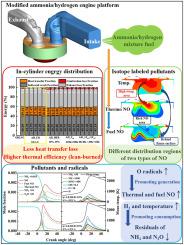研究重型火花点火式发动机中装料成分和温度对氨/氢燃烧的影响
IF 8.1
2区 工程技术
Q1 CHEMISTRY, PHYSICAL
引用次数: 0
摘要
氨作为一种氢载体,具有生产技术成熟、储存方便等特点,近年来已成为最有前途的零碳燃料之一。在火花点火(SI)发动机中使用氨/氢混合燃料,解决了纯氨火焰速度低、点火能量要求高、可燃范围窄等问题,引起了广泛关注。本研究对高负荷运行时氨气/氢气喷嘴燃料喷射(PFI)发动机的燃烧和排放过程进行了数值分析,以研究进气氢能比(HER)、当量比(φ)、进气温度和燃烧室壁温对能量分布和污染物的影响。结果表明,在相同的氢能比(25%)条件下,由于燃烧和壁面热损失减少,贫燃模式的热效率比定燃模式高。然而,贫燃状态下较低的气缸温度抑制了 NH3 参与还原反应和 N2O 的消耗,增加了这两种污染物的残留量。在贫油条件下,过量的 O 自由基促进了氮氧化物的排放,同时还利用同位素标记法讨论了燃料氮氧化物和热氮氧化物的排放途径。在化学计量模式下,增加燃料 HER(10%-25%)对提高热效率的影响较小,但会通过增加 H 自由基和气缸温度促进 NH3 和 N2O 的消耗。研究还表明,优化进气温度和壁温可有效减少 NH3 和 N2O 的排放,分别减少 87.5% 和 71.7%,同时略微减少氮氧化物。本文章由计算机程序翻译,如有差异,请以英文原文为准。

Investigating the impacts of charge composition and temperature on ammonia/hydrogen combustion in a heavy-duty spark-ignition engine
Ammonia, as a hydrogen carrier with mature production technology and convenient storage, has become one of the most promising zero carbon fuels in recent years. The use of ammonia/hydrogen mixture fuel in spark ignition (SI) engines has drawn significant attentions since it solves the problems of low flame speed, high ignition energy requirement and narrow flammable range of pure ammonia. In this study, the combustion and emission processes of an ammonia/hydrogen port fuel injection (PFI) engine at high load operation are numerically analyzed to investigate the effects of intake hydrogen energy ratio (HER), equivalence ratio (φ), intake temperature and combustion chamber wall temperature on energy distribution and pollutants. The results indicate that under the same HER of 25%, the lean-burned mode provides favorable thermal efficiency compared to stoichiometric mode due to reduced combustion and wall heat loss. However, lower cylinder temperature at lean condition inhibits the participation of NH3 in the reduction reactions and the consumption of N2O, increasing the residuals of both pollutants. The NOx emission is promoted by excessive O radicals at lean conditions, and the pathways of fuel NOx and thermal NOx are also discussed using an isotope labeling method. At stoichiometric mode, increasing fuel HER (10%–25%) only has minor impacts on improving thermal efficiency, but can promote the consumption of NH3 and N2O by increasing H radicals and cylinder temperature. The study also shows that optimizing the intake and wall temperatures can effectively reduce NH3 and N2O emissions by 87.5% and 71.7%, respectively, while slightly reducing NOx.
求助全文
通过发布文献求助,成功后即可免费获取论文全文。
去求助
来源期刊

International Journal of Hydrogen Energy
工程技术-环境科学
CiteScore
13.50
自引率
25.00%
发文量
3502
审稿时长
60 days
期刊介绍:
The objective of the International Journal of Hydrogen Energy is to facilitate the exchange of new ideas, technological advancements, and research findings in the field of Hydrogen Energy among scientists and engineers worldwide. This journal showcases original research, both analytical and experimental, covering various aspects of Hydrogen Energy. These include production, storage, transmission, utilization, enabling technologies, environmental impact, economic considerations, and global perspectives on hydrogen and its carriers such as NH3, CH4, alcohols, etc.
The utilization aspect encompasses various methods such as thermochemical (combustion), photochemical, electrochemical (fuel cells), and nuclear conversion of hydrogen, hydrogen isotopes, and hydrogen carriers into thermal, mechanical, and electrical energies. The applications of these energies can be found in transportation (including aerospace), industrial, commercial, and residential sectors.
 求助内容:
求助内容: 应助结果提醒方式:
应助结果提醒方式:


